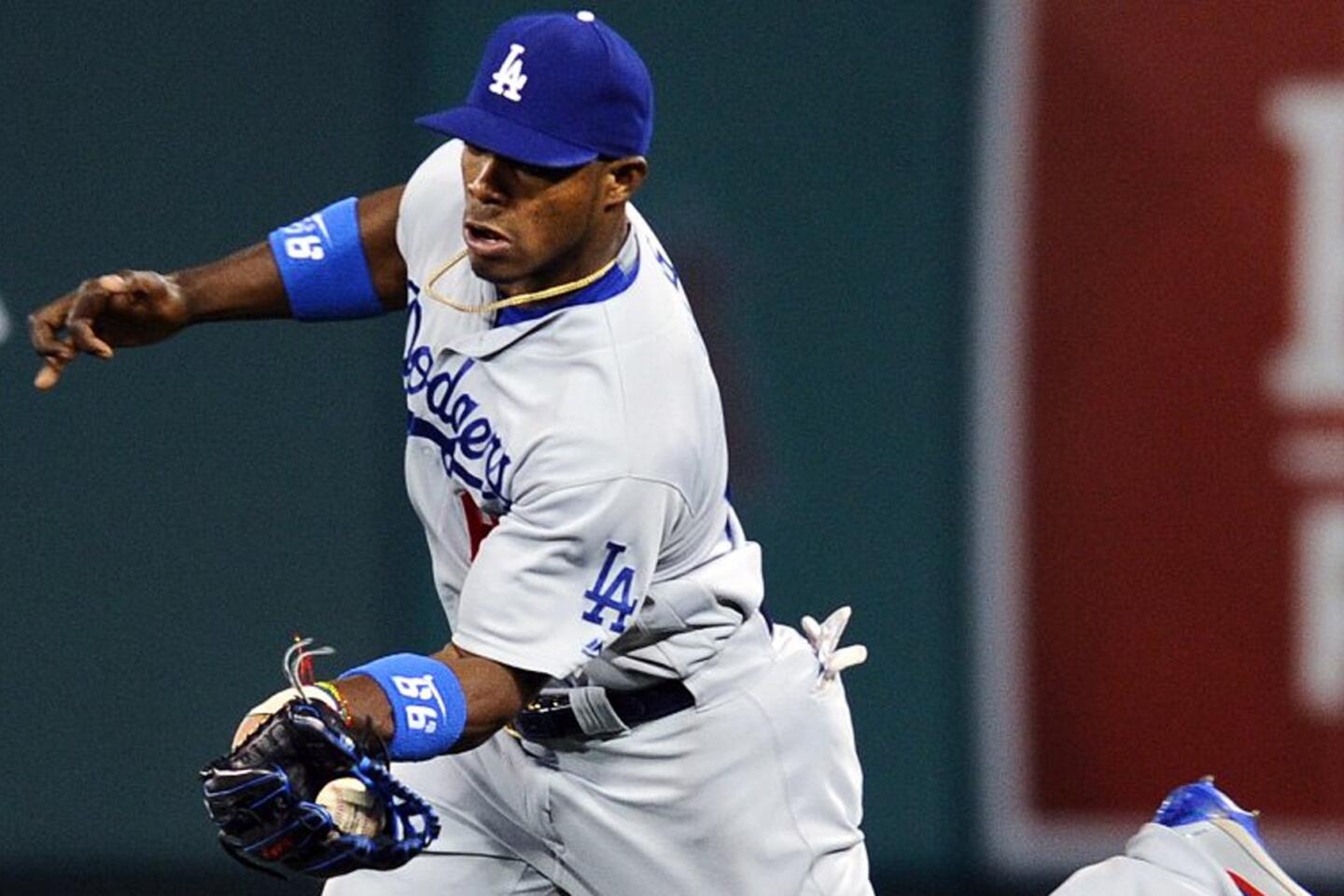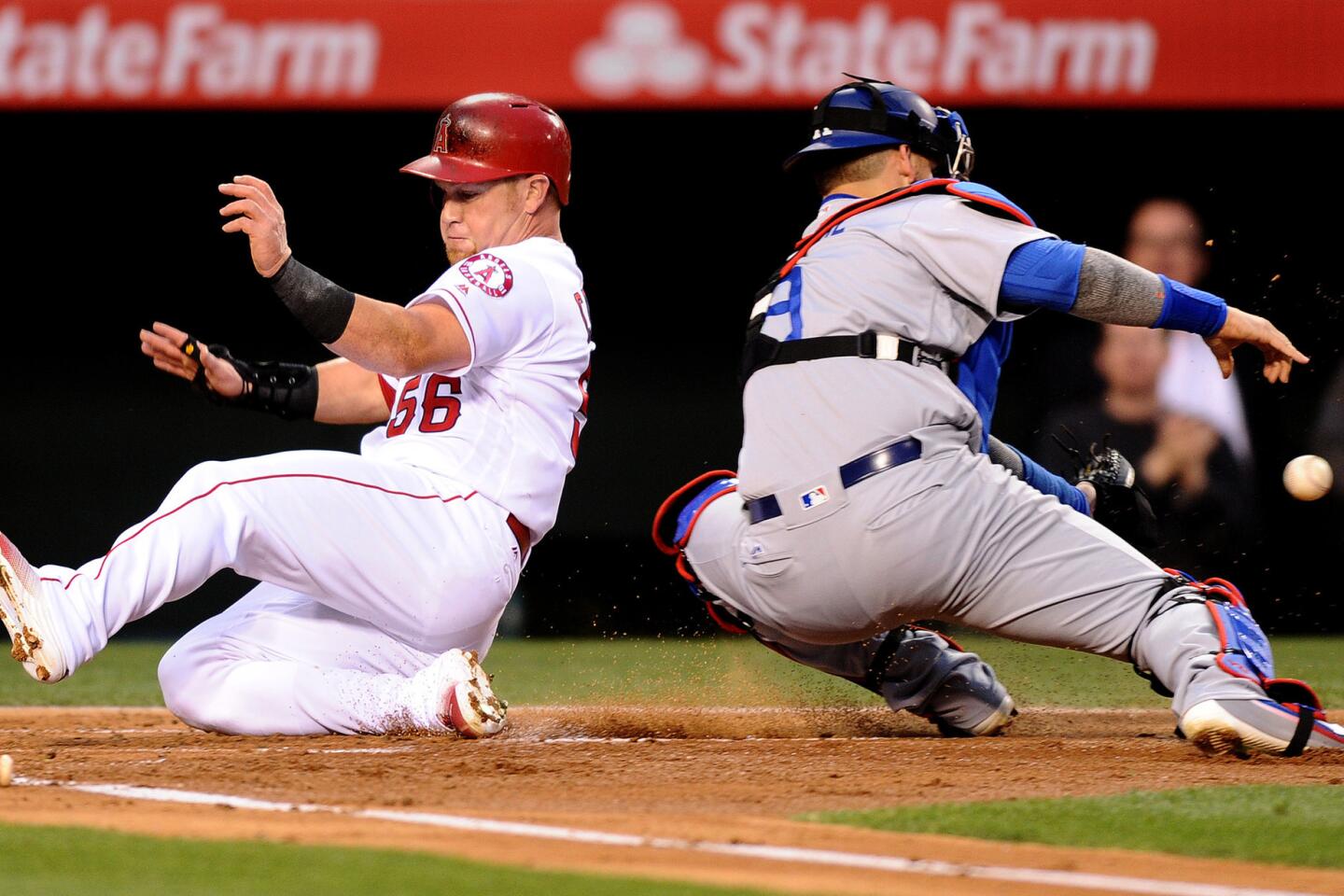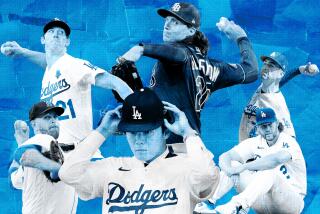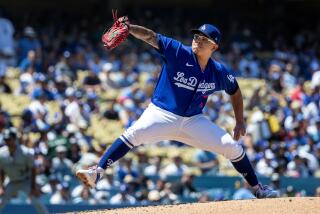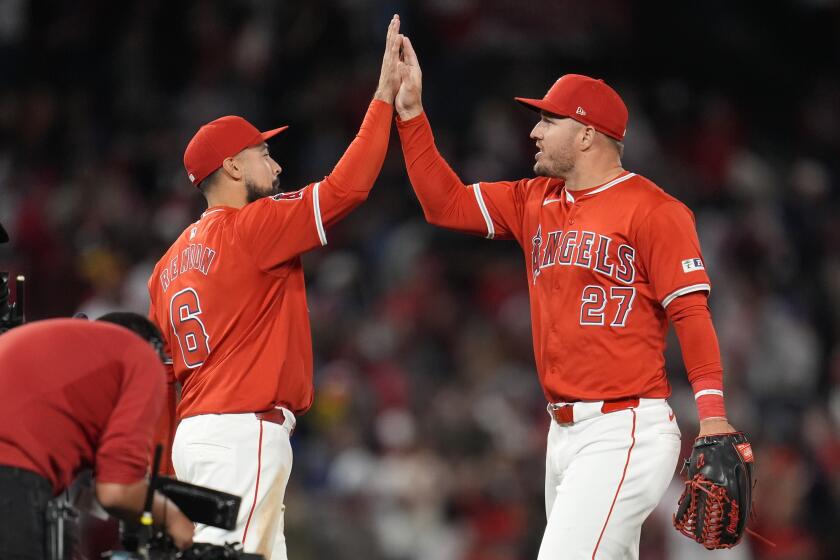Julio Urias’ time will come but Dodgers must give him chance to develop

Dodgers left-handed pitcher Julio Urias smiles while talking to teammates in the dugout during a spring training game on Mar. 14.
In the Dodgers clubhouse on a recent afternoon, one of the team’s veteran players had a question.
When is Julio Urias coming up?
It’s only natural to wonder. What Clayton Kershaw is doing in the major leagues, Urias is doing at triple-A Oklahoma City, his 1.25 earned-run average through seven games by far the best in the offense-inclined Pacific Coast League.
As one of the 25 best players in the organization, Urias would already be in Los Angeles if roster decisions were based entirely on ability. They’re not, of course.
Urias is still 19. The Dodgers have to protect his prized left arm and they have to be mindful of his development.
That being the case, they shouldn’t be talking of promoting him any time soon. They shouldn’t have to.
It’s absurd that a supposed championship contender with a $230-million payroll is thinking of calling up a teenage pitcher this early in the season.
The Dodgers created this problem when their front office constructed their rotation and bullpen largely out of spare parts. The predictable dysfunction that has resulted from that strategy is what has inspired the conversations about whether Urias should be used as a reliever to fortify the wobbly bridge to closer Kenley Jansen, with the aforementioned veteran offering the opinion that Urias is already the team’s most viable eighth-inning option.
Now, Urias’ future is in the hands of the same executives who made a series of questionable trades and free-agent acquisitions over the last year.
In a phone interview this week, Urias said he didn’t know what the Dodgers have planned for him.
“But in my mind, it’s the same,” he said in Spanish. “My mind is on Los Angeles.”
The Dodgers’ options are somewhat limited by a decision the team made last year to allow Urias to undergo a midseason operation to remove a benign mass from his left eyelid. The organization figured that would be a creative way to control his workload.
Urias finished the season with only 801/3 innings, down from 872/3 innings the previous year.
The result is that he still doesn’t have the sufficient arm strength to be a reliable starter in the major leagues. He’s limited to around 80 pitches per start, which was enough to get him through six innings in each of his last three appearances. In the major leagues, 80 pitches could translate into a four- or five-inning start, which would burden an already-unstable bullpen. Before turning to Urias for rotation help, the Dodgers will explore other options, among them Hyun-Jin Ryu and Brandon McCarthy, who are returning from injuries.
So if Urias is called up, it will probably be as a reliever, a role in which the Dodgers would be able to better control his pitch and inning counts. The problem with that scenario is that it could compromise Urias’ chances of being part of the major league rotation in 2017.
Urias has pitched 36 innings this year, meaning he probably has around 80 more to pitch this season. If the objective is to prepare him to be part of the major league rotation next year, he should pitch the majority of the innings as a starter in triple A, where he could gradually increase his pitch count and become more accustomed to pitching through a lineup multiple times. The Dodgers could still promote him as a reliever in September, when their expanded roster would make it even easier to control his workload.
When Fernando Valenzuela came up to the major leagues as a 19-year-old reliever in September 1980, he did so after pitching 174 innings in double A that season.
The Dodgers are venturing into the unknown with Urias, acknowledged Andrew Friedman, the team’s president of baseball operations.
“In Julio’s case, in particular, it’s a little more unique because of how advanced he is at such a young age,” Friedman said. “I think as an industry we know more about how to limit starting pitcher injuries than we did 10 years ago, but there’s no question in my mind we’ll know significantly more five years from now.
“I think it’s important not to overstate what you don’t know, but until we know more, you almost always have to err on the side of caution.”
For his part, Urias remains confident in how the Dodgers are handling him. He added that he is pleased with the progress he has made this season, particularly with controlling his emotions.
“I know that whenever I threw three consecutive balls last year, I would lose it,” he said. “Now, if I don’t do what I wanted with a certain batter or a certain pitch, I move on to the next batter, the next pitch and do better.
With his parents in Mexico always asking him to translate articles written about him, Urias knows there is a growing buzz about his possible promotion.
“It makes me proud that some people are saying they already want to see me there, but my time will come,” Urias said. “God’s timing is always perfect.”
Still, he is treating every start as if it is a final audition for the major leagues. As for whether he gets there as a starter or a reliever, he said he doesn’t care.
His only wish is that if he is called up to pitch out of the bullpen, he would like to pitch in the minors as a reliever beforehand.
“The major leagues are the ultimate. It doesn’t matter where you pitch or where you hit,” he said. “Whatever it is, you do it. If they say the eighth, the seventh, against a left-handed hitter, you have to do what they ask.”
More to Read
Go beyond the scoreboard
Get the latest on L.A.'s teams in the daily Sports Report newsletter.
You may occasionally receive promotional content from the Los Angeles Times.


